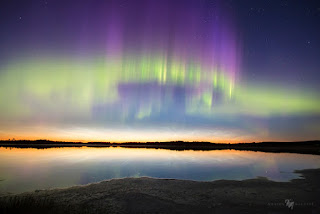Friday, July 13, 2018
Northern Lights and Noctilucent Clouds - NATURAL PHENOMENA
Skies after the near-solstice sunset on June 17 are reflected in this calm lake. The tranquil twilight scene was captured near Bashaw, Alberta, Canada, northern planet Earth. Usually spotted at high latitudes in summer months, night shining or noctilucent clouds hang just above the horizon, transfusing light into a darker sky.
Near the edge of space, the icy apparitions are condensations on meteoric dust or volcanic ash still in sunlight at extreme altitudes. Also near the edge of space on this short northern night, solar activity triggered the lovely apparition of aurora borealis or northern lights.
What are noctilucent clouds?
Noctilucent clouds are also called Polar Mesospheric Clouds, PMCs. They are 80-85 km high (50-53 mile) a few km below the mesopause, the coldest part of the atmosphere.
NLCs are comprised of extremely small ice crystals some 0.1 micron (1/10,000 mm) diameter.
We see them by sunlight scattered by the crystals which are not large enough to show iridescent effects. Their bluish coloration is likely a result of absorption of red light by the stratospheric ozone layer. Occasionally they show reds and golds from the colour of low sunlight illuminating them.
NLC formation requires a combination of very low temperatures, a source of water vapour, and nuclei on which ice can grow.
Image & info via APODhttps://apod.nasa.gov/apod/astropix.html
Image Credit & Copyright: Adrien Mauduit https://www.adphotography-online.com/
Subscribe to:
Post Comments (Atom)

No comments:
Post a Comment